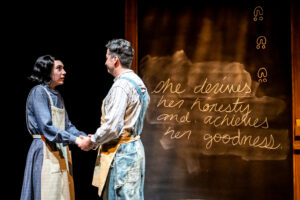Art about trauma is hard, and art about atrocities still being reckoned with by the people who experienced them is even harder. Despite that difficulty, 1939 gracefully and powerfully shows the diverse and peopled history of residential schools in a way that honours the horror endured while taking pains to celebrate the hard-earned triumphs and complex feelings of those enduring it.
The play has instilled in me the deepest understanding of what it was like to survive a residential school of any art I’ve seen on the topic. It’s a brilliant thing with a brilliant cast and truly spectacular set design and lighting. 1939 is a masterclass in theatre and in art about traumatic history.

The story follows five of the school’s students as they’re drafted into putting on a Shakespeare play to be presented to King Edward VI on his first tour of Canada. Over the five months of rehearsing All’s Well That Ends Well, the students keep finding more of themselves in the play than they expected was possible. But seeing yourself in something can be dangerous when the whole reason you’re being kept at the school is to erase your sense of self. The teachers the audience gets to see are bumbling and could be mistaken for comedic, except for the constant reminder of the power they exert over these kids with the express purpose of destroying their cultures.
The experiences these kids have isn’t uniform either, with each of them coming from a different cultural background and each choosing a different way to engage with being trapped: a Métis boy feeling isolated from white and Indigenous spaces; a girl who can’t remember where she came from; a proud Mohawk girl fighting to maintain and use her medicinal knowledge; siblings disagreeing on how to make space for themselves in the world. Their perspectives are all honoured and their decisions understood.
Despite their grim situation, the play is often legitimately funny. It’s a gallows humour, but the jokes do not dismiss the students’ situation; rather, they highlight the strength of their spirit. Jokes are often brought to a halt when a teacher arrives, or when their laughter brings down swift and callous punishment, but no matter what, they keep finding ways to make each other laugh. And always, no matter the risk, there is the indelible mark of who they are, which they are constantly—often quietly—fighting to keep alive. Be it doing iambic pentameter in a circle dance or tending each other’s lashing wounds with plants, they are taking every hard-won triumph they can, even at great risk.
The set design further shared the inner worlds of the kids in an ingenious way. Massive and imposing blackboards make up the backdrop of the stage, and in scene transitions the students write out their thoughts and feelings. Sometimes words in their languages, short letters to their parents, quotes from the play they were rehearsing, or, hauntingly, “I WAS HERE.” It didn’t matter what they wrote, whether it was a cry for home or engaging with what the teachers wanted them to engage with—it was all erased as soon as possible. Co-writer and director Jani Lauzon put it best when she said the set was indicative that “the walls held memories and could talk.”
I think I could truly go on for hours about this show and I would never touch on everything. But one way to see everything I might talk about is by going to see it, which I strongly encourage everyone to do. I can’t recommend it enough.
1939
Various times and days,
until Sunday, November 24
Pay-what-you-can tickets,
Belfry Theatre
belfry.bc.ca
